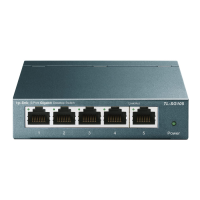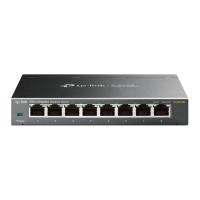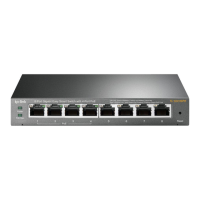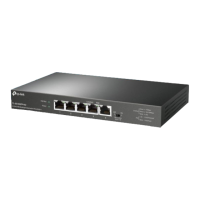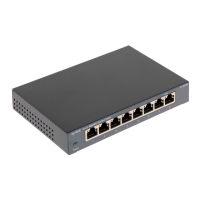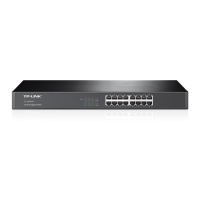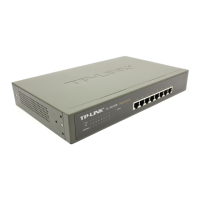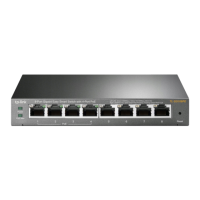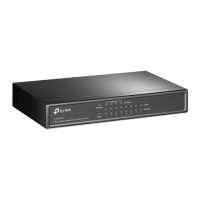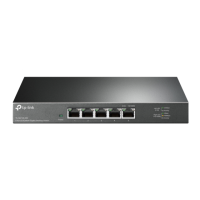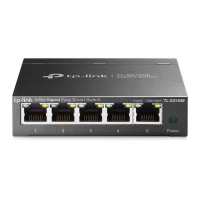Do you have a question about the TP-Link TL-SG105E and is the answer not in the manual?
Target audience and their required knowledge for using the guide.
Explains symbols, formatting, and conventions used throughout the document.
Provides links to additional resources like software, documentation, and support.
Introduces the Unmanaged Pro Switch and its key features.
Details the physical layout and components of the switch.
Describes the front panel elements, including LEDs and RJ45 ports.
Details the rear panel components like security slot, reset button, and power socket.
Step-by-step guide on accessing and logging into the switch's web interface.
Overview of system management capabilities and supported features.
Instructions for viewing and specifying device description and system information.
Guides on setting up the switch's IP address using DHCP or manually.
Procedures for modifying the administrator's username and password.
Steps to save and restore the switch's configuration settings.
How to restart the switch to apply configuration changes or resolve issues.
Instructions for resetting the switch to its factory default settings.
Guide on updating the switch's firmware for new features and performance.
Lists default settings for various system parameters.
Overview of the switching feature and its supported functionalities.
Details on setting port status, speed, duplex mode, and flow control.
Steps to enable/disable IGMP snooping and report message suppression.
Guide on creating Link Aggregation Groups to increase bandwidth and reliability.
Practical examples for configuring IGMP Snooping and LAG.
Lists default settings for port configuration, IGMP snooping, and LAG.
Overview of monitoring features for switch traffic and status.
How to check detailed traffic statistics for each port.
Steps to set up port mirroring for traffic analysis.
Guide on using the cable test feature to diagnose network cable issues.
Instructions on enabling and disabling the loop prevention feature.
Lists default settings for port mirror and loop prevention.
Explains VLAN technology and its benefits for network management and security.
Steps to configure MTU VLAN and set the uplink port.
Guide on creating and managing port-based VLANs.
Detailed instructions for configuring 802.1Q VLAN and PVID.
A practical example demonstrating 802.1Q VLAN configuration.
Lists default settings for MTU VLAN, Port Based VLAN, and 802.1Q VLAN.
Overview of Quality of Service (QoS) technology and its importance.
Explains QoS modes (Port, 802.1P, DSCP) and their configurations.
Steps to set ingress and egress rates for bandwidth management.
Guide on configuring storm control to prevent broadcast storms.
A practical example showing how to configure QoS for traffic prioritization.
Lists default settings for QoS basic, bandwidth control, and storm control.
| Switch type | Managed |
|---|---|
| Switch layer | L2 |
| Quality of Service (QoS) support | Yes |
| Installed SFP modules quantity | 0 |
| Basic switching RJ-45 Ethernet ports type | Gigabit Ethernet (10/100/1000) |
| Basic switching RJ-45 Ethernet ports quantity | 5 |
| 10G support | No |
| Number of VLANs | 32 |
| Networking standards | IEEE 802.1p, IEEE 802.1Q, IEEE 802.3, IEEE 802.3ab, IEEE 802.3u, IEEE 802.3x |
| Virtual LAN features | Port-based VLAN |
| Cable types supported | Cat3, Cat4, Cat5, Cat5e, Cat6 |
| Copper ethernet cabling technology | 1000BASE-T, 100BASE-TX, 10BASE-T |
| Jumbo frames | 16000 |
| Forwarding rate | 7.44 Mpps |
| MAC address table | 2000 entries |
| Packet buffer memory | 1 MB |
| Certification | FCC, CE, RoHS |
| Product color | Black |
| Rack mounting | - |
| Compatible operating systems | Microsoft Windows XP, Vista Windows 7, Windows 8, MAC OS, NetWare, UNIX / Linux |
| Heat dissipation | 9.07 BTU/h |
| Storage temperature (T-T) | -40 - 70 °C |
| Operating temperature (T-T) | 0 - 40 °C |
| Storage relative humidity (H-H) | 5 - 90 % |
| Operating relative humidity (H-H) | 10 - 90 % |
| Package type | Box |
| Package depth | 128 mm |
| Package width | 125 mm |
| Package height | 92 mm |
| Package weight | 450 g |
| Cables included | AC |
| Power source | DC |
| Input current | 0.6 A |
| Input voltage | 5 V |
| Power consumption (max) | 2.82 W |
| Depth | 98 mm |
|---|---|
| Width | 100 mm |
| Height | 25 mm |
